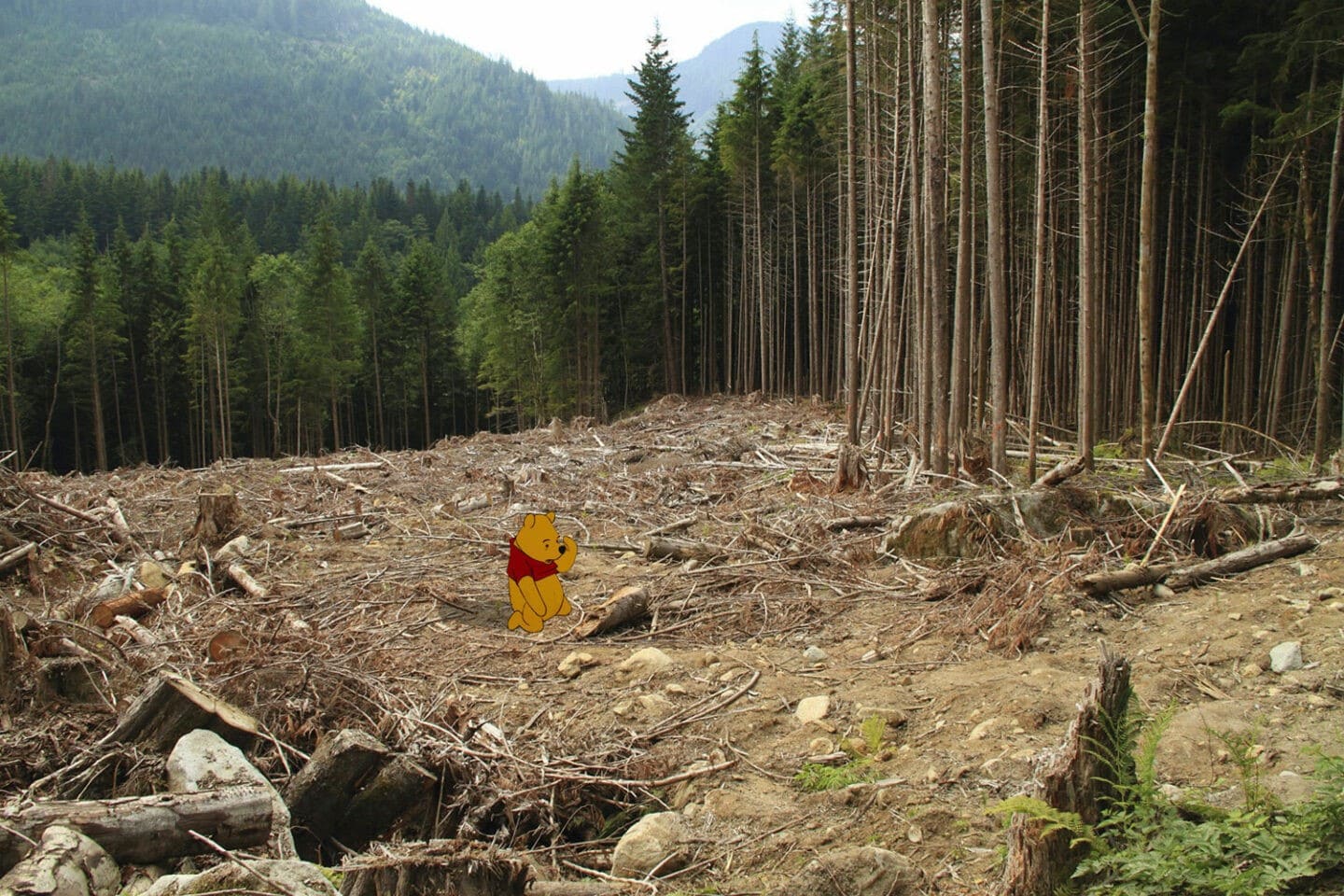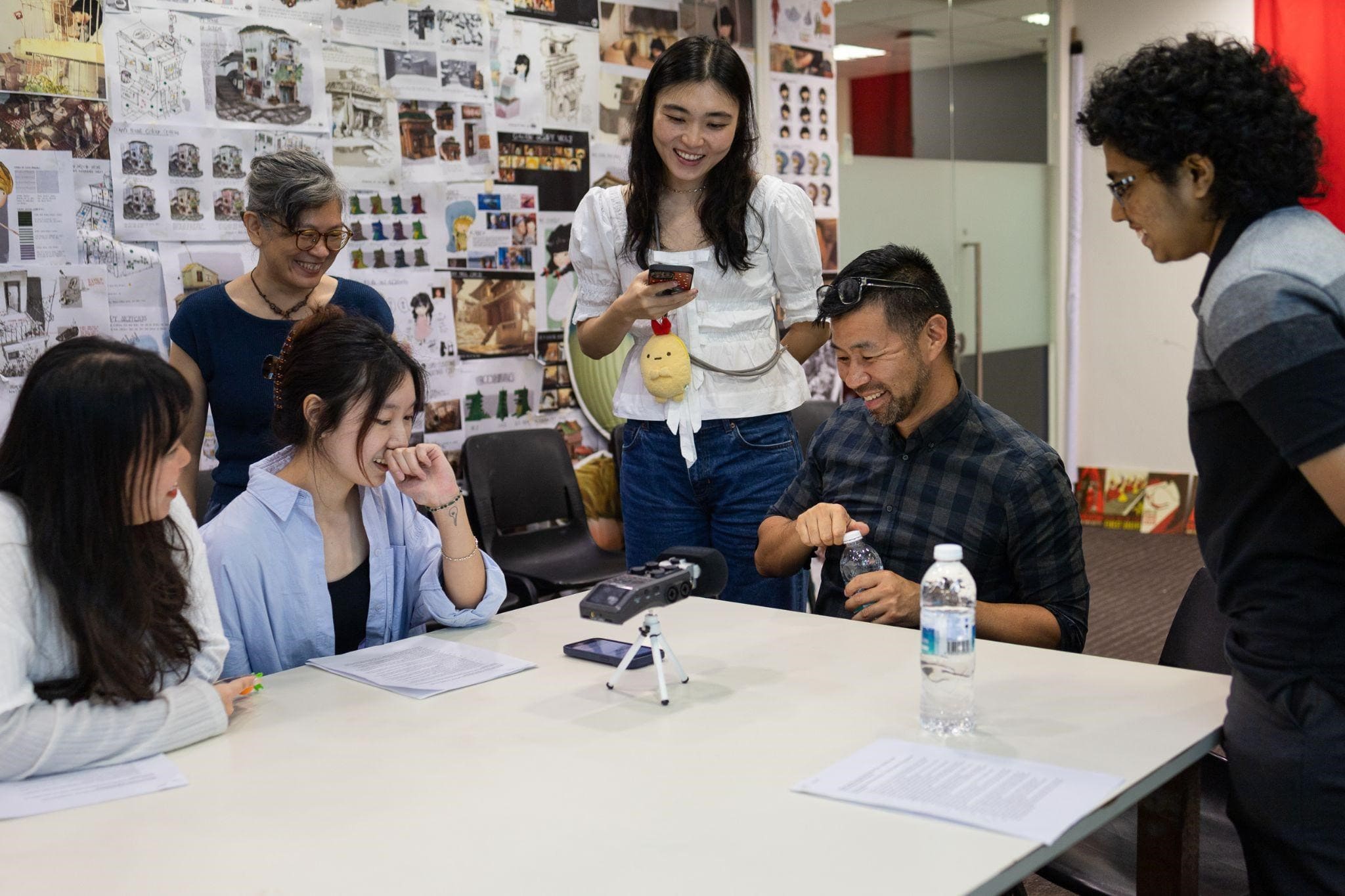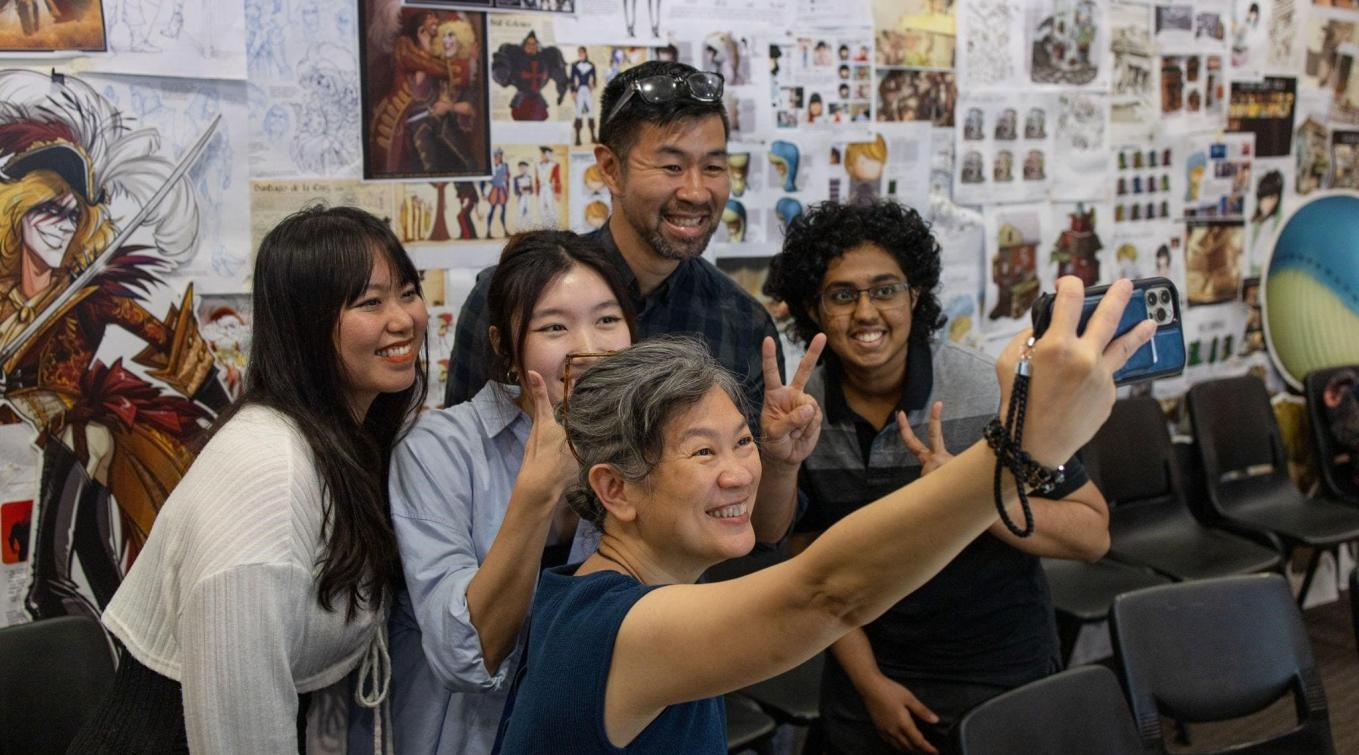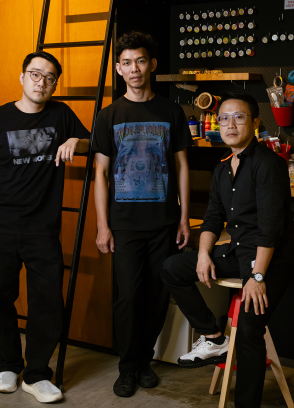Veteran animator Jeff Hong (back row, third from left) together with BA (Hons) Animation Art students Rene Daniel Lim, Megan Lim Jia Yu and Tansha Surendra (back row from left), as well as lecturer Dr Gan Sheuo Hui.
In animator and visual artist Jeff Hong’s works, familiar fairy tale characters find themselves in disenchanting situations. The little mermaid, for instance, flops onto a beach, fins covered in crude oil in an oil slick. Meanwhile, Belle, from Beauty in the Beast, attends a plastic surgery consultation and is told to change just about everything on her face.

These alternative retellings are part of Jeff’s Unhappily Ever After series which were presented at Gardens By The Bay in a special exhibition in October 2024.
In Singapore for the opening, Jeff dropped by LASALLE for a lecture with students from the Puttnam School of Film & Animation, followed by a conversation with selected students where the animation veteran discussed his body of work, his experiences working as a storyboard artist for Disney, as well as how to keep going as an independent artist and finding your creative voice.
How did your experience working on films, like Disney’s Hercules and Mulan, shape your voice and approach as an independent artist?
Honestly, my work at Disney was more about learning the animation process. It taught me more about the animation pipeline which I was really interested in, and I feel like I still draw very much like how I learned at Disney when I was a clean-up artist. I started very young, at 17.
It wasn’t until I went to art school that I really learned to be a more independent artist, and learned to put my own message into my own art, getting a little more political or social in the works I was creating.
Can you share an experience where a director’s feedback significantly altered your storyboard and how do you cope with criticism?
With storyboarding, there’s always like a different viewpoint that a director or supervisor can provide that maybe you didn’t quite see. I wasn’t strong at pushing silly poses or adding gags — but for some of the directors I’ve worked for, they would really try to push the silliness. Some directors are more about the emotional connection in the storyboards.
As a storyboard artist you really can’t take any criticism personally, it's all about just making the show better.
What do you consider to be key elements for effective storytelling in animation, especially when tackling really complex themes?
One of the most important aspects in storytelling is to ensure that there's some emotional connection to these characters, that they have personality and heart. What I learned about Disney movies is that it's all about making sure these characters feel real and emotional so that the viewer forgets that they're animated.
As an animator, you’re basically the actor for these drawings. You're breathing the human aspect into it, otherwise they're just 2D drawings that are moving. There has to be a human element to these characters and I think that's what makes animation really strong.
What motivated you to create your collection of Unhappily Ever After? And how do you see it challenging perceptions of traditional fairy tales?
Animation was my passion, but I went to Rhode Island School of Design, which is very focused on conceptual ideas. They didn’t teach us how to draw — they just assumed you already knew how — so it was more about putting intellectual thought into your work. Our illustration classes were mainly critiques — you’d put your work up on the wall, and we’d spend six hours critiquing it.
My Unhappily Ever After series combines my love for Disney characters with something more intellectual and conceptual. It brought together my background in Disney, my art school education, and my passion for sustainability, human rights and ethical causes. I’m also into punk music, which is about equal rights and animal welfare, so all those ethics came into play as well. Everything kind of meshed into this one series, making it personal and reflective of my interests.
Could you tell us more about how Unhappily Ever After deconstructs the perfection presented in fairy tales and animated stories?
I feel like narratives, especially in Hollywood movies, tend to focus on the ‘Hollywood ending’, with things being very perfect. This is especially present in Disney — like with The Hunchback of Notre Dame, they changed the whole ending of the book to give the hunchback a happy ending. Even though there’s always a problem or a conflict, it gets resolved.
With my series, I wanted to show these characters in real life, which doesn’t always get a happy ending. Real life is hard; there are issues in the world that don’t get solved and things we constantly have to work on, like finding solutions or rethinking how we treat people and the environment. Life can be difficult, and my work reflects that — how we can improve how we treat others, the world, and the environment.
Children’s movies, by contrast, are often portrayed as a very safe, happy place. Unfortunately, sometimes my art can be quite harsh for children — like showing Winnie the Pooh losing his home. It’s definitely a stark realisation for them that this can happen in real life.

As an artist, do you have certain boundaries you adhere to, particularly regarding how you portray your work?
Absolutely. I strive to maintain respect for diverse beliefs and values, even though I'm not religious myself. I aim to ensure that my work doesn't offend anyone and honours their perspectives, whether it relates to religion, love or other aspects of their identities. For me, it’s essential to treat everyone as equals in my creative process.
Your work often elicits a wide range of reactions. How do you navigate the attention and potential backlash that comes with that?
My journey into the viral space began in 2014 when I shared my work on Reddit, which eventually led to widespread recognition. While I’ve received both positive and negative feedback — particularly from more conservative outlets — I’ve learned that not everyone will resonate with my work, and that’s okay.
I focus on what brings me joy and fulfillment as an artist, continuing to create what I believe in rather than seeking to please everyone. That's what I really like about the internet, which is its ability to amplify good ideas and allow my work to reach a diverse audience quickly. Because all my work is digital, I never prepared to show it in a gallery setting at all. I just posted it online. That makes art more freeing. It's almost like street art — the internet is the virtual version of the street.
In a past interview, you mentioned that your journey was still unfolding. How have your perspectives on your own work evolved since then? Where do you see yourself heading now as an independent artist?
As an artist you wanna keep working on something new. My personal path to being an individual creative artist is coming up with good ideas that are interesting and that people care about, but also that makes me happy.
After Unhappily Ever After, I wanted to do another project that would be as impactful, but also light-hearted. So right after this I did a project called Punktendo, which put singers and personalities from punk bands in a Nintendo game setting. And then I did another sister site to this called Trumptendo in 2016, which went viral. That was very fun to do.
That said, it's very hard to continually create good ideas and have success with them. I did Unhappily Ever After over 10 years ago, and while I’ve done other projects since then, I keep coming back to this one.
What advice would you give to animation students seeking to discover their unique creative voices?
It's vital for students to explore what truly interests them within animation. Whether it’s character design, storyboarding or another niche, finding your passion is crucial.
When reviewing portfolios, I prioritise storytelling ability over specific styles. It’s about showcasing your unique perspective, even within a collaborative team environment. Each animator should strive to bring their individuality to the project, whether through humour, style or creative concepts.

This interview has been edited and condensed for clarity.




